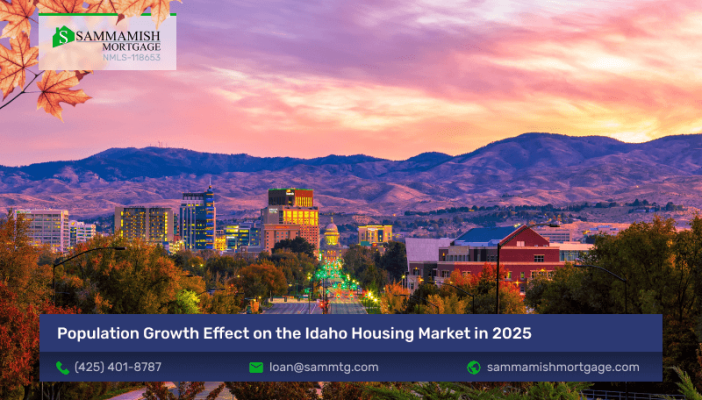No Obligation and transparency 24/7. Instantly compare live rates and costs from our network of lenders across the country. Real-time accurate rates and closing costs for a variety of loan programs custom to your specific situation.

If you live in Idaho, you probably already know that the state’s population has increased significantly in recent years.
According to the U.S. Census Bureau, the statewide population grew by nearly 7% from 2020 to 2023. That was well above the national growth rate for that same period.
But how has this trend affected the housing market in Idaho?
This report provides a retrospective summary of population growth in Idaho, going back to before the pandemic. It also shows the population growth effect on the Idaho housing market looking forward into 2025.
Historically speaking, Idaho was one of the least populated U.S. states. But that has changed in more recent years, as the state steadily climbs up through the ranks.
According to a Seattle Times report published earlier this year, Idaho’s population is closing in on the 2 million resident milestone. This steady growth has been partly fueled by new arrivals from West Coast states including Washington, Oregon, and California.
Idaho’s population growth has been reinforced by an uptick in international immigration, which began with the easing of pandemic restrictions in 2022.
According to the Idaho Department of Labor, the state gained nearly 26,000 residents between July 2022 and July 2023 alone. This solidifies its position as one of the fastest-growing states in the nation.
This growth trajectory is expected to continue going forward, as well. Experts predict the state could reach the 2 million population milestone later this year or in early 2025.
Matthew Hurt, an economist with the Idaho Division of Financial Management, believes the state will reach that threshold during the winter of 2024.
Population growth has affected the Idaho real estate market in several ways, mainly by increasing home prices across the board. More on that in a moment.
So what’s behind Idaho’s steady population growth in recent years? As usual, it’s a combination of overlapping factors, rather than just one thing.
The influx of new residents has had a profound impact on Idaho’s real estate market and broader economy. Increased housing demand in Idaho, as well as rising demand for jobs and infrastructure, drives economic growth and development.
But rapid population growth can also present challenges, such as the potential for rising housing costs. So let’s talk about that next.
Idaho’s population growth brought more home buyers into the market, increasing competition and home prices at the same time. We saw an extreme version of this during the pandemic, when a flood of new residents poured into the Boise metro area.
The market has slowed down since the housing boom, and inventory levels have rebounded. When measured by both the “time on market” or “months of supply” metrics, the Idaho real estate market has returned to something resembling normalcy.
Home prices, however, remain elevated. The average home value in Idaho is currently much higher than it was prior to the pandemic.
As you can see in the graph below, the Gem State experienced an unprecedented rate of price growth from 2020 to 2022. This culminated in an all-time high during the summer of 2022.
The statewide median home price rose by more than $200,000 from the start of 2020 to the summer of 2022. Prior to that, the state of Idaho had never experienced such a sharp and sustained surge in home values.
And while prices have eased since then, they’re still a lot higher than just a few years ago.
In short, Idaho is a different kind of real estate market these days. The overall pace of the market has slowed, and bidding wars have become increasingly rare.
But with a median home price that now exceeds the national median, Idaho is no longer a beacon of affordability for buyers.
Population growth also impacts the rental market in Idaho, especially in cities experiencing rapid demographic shifts, such as Boise, Meridian, and Nampa. Many prospective buyers who find prices too high may look to rent instead, driving up demand and prices in that segment as well. As Idaho’s population has surged, the increased demand for housing has driven rental prices upward across the state.
Key effects of population growth on Idaho’s rental market are as follows:
Population growth in Idaho presents unique challenges for first-time homebuyers, as demand has surged alongside home prices, inventory shortages, and intensified competition. Some of the major barriers that first-time homebuyers face in Idaho’s fast-evolving market are as follows:
What does the 2025 Idaho housing market forecast look like?
Population growth will continue to be a major factor for the Idaho real estate market in 2025. But it will likely be more muted than what occurred during the previous four years.
Home prices are expected to rise at a more modest pace, compared to the surge shown in the preceding graphic. A slow but steady rise seems to be the most likely scenario.
Competition among buyers has also eased, a trend that will continue in 2025. With a slower pace and fewer competing buyers, house hunters can take a bit more time for price research and other forms of due diligence.
The bottom line is that there is certainly a population growth effect on the Idaho housing market, making it more expensive. But aside from that, the Idaho housing market appears to be moving in a buyer-friendly direction for a change.
Sammamish Mortgage serves home buyers and homeowners all across the state of Idaho. We offer a wide range of mortgage products and a fully transparent pricing model. Visit our website today to get an instant rate quote, or contact us if you have mortgage questions or would like to apply for a loan.


Whether you’re buying a home or ready to refinance, our professionals can help.
{hours_open} - {hours_closed} Pacific
No Obligation and transparency 24/7. Instantly compare live rates and costs from our network of lenders across the country. Real-time accurate rates and closing costs for a variety of loan programs custom to your specific situation.